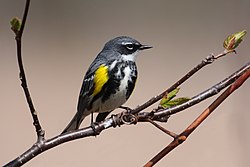This article includes a list of general references, but it lacks sufficient corresponding inline citations .(October 2024) |
| Myrtle warbler | |
|---|---|
 | |
| Scientific classification | |
| Kingdom: | Animalia |
| Phylum: | Chordata |
| Class: | Aves |
| Order: | Passeriformes |
| Family: | Parulidae |
| Genus: | Setophaga |
| Species: | S. coronata |
| Binomial name | |
| Setophaga coronata (Linnaeus, 1766) | |
| Synonyms | |
| |
The myrtle warbler (Setophaga coronata) is a small New World warbler. It is considered a subspecies of the yellow-rumped warbler and its own species by different classification societies. The myrtle warbler has a northerly and easterly distribution, with the Audubon's warbler farther west. It breeds in much of Canada and the northeastern United States. It is migratory, wintering in the southeastern United States, eastern Central America, and the Caribbean. It is a rare vagrant to western Europe, and has wintered in Great Britain.
Contents
The summer male myrtle warbler has a slate blue back, and yellow crown, rump and flank patch. It has white tail patches, and the breast is streaked black. The female has a similar pattern, but the back is brown as are the breast streaks. The myrtle can be distinguished from the similar Audubon's warbler by its whitish eyestripe, white (not yellow) throat, and contrasting cheek patch. Their trill-like songs, nearly indistinguishable, consist of a three or four syllable "tyew-tyew-tyew-tyew", sometimes followed by three more "tew"s. The call is a hard check.
Its breeding habitat is a variety of coniferous and mixed woodland. Myrtle warblers nest in a tree, laying four or five eggs in a cup nest.
These birds are insectivorous, but will readily take wax-myrtle berries in winter, a habit which gives the species its name. Experienced birders recognize myrtle warblers with the naked eye by their flycatcher-like habit of making short flights from their perch in search of bugs. They form small flocks on migration or in winter.
